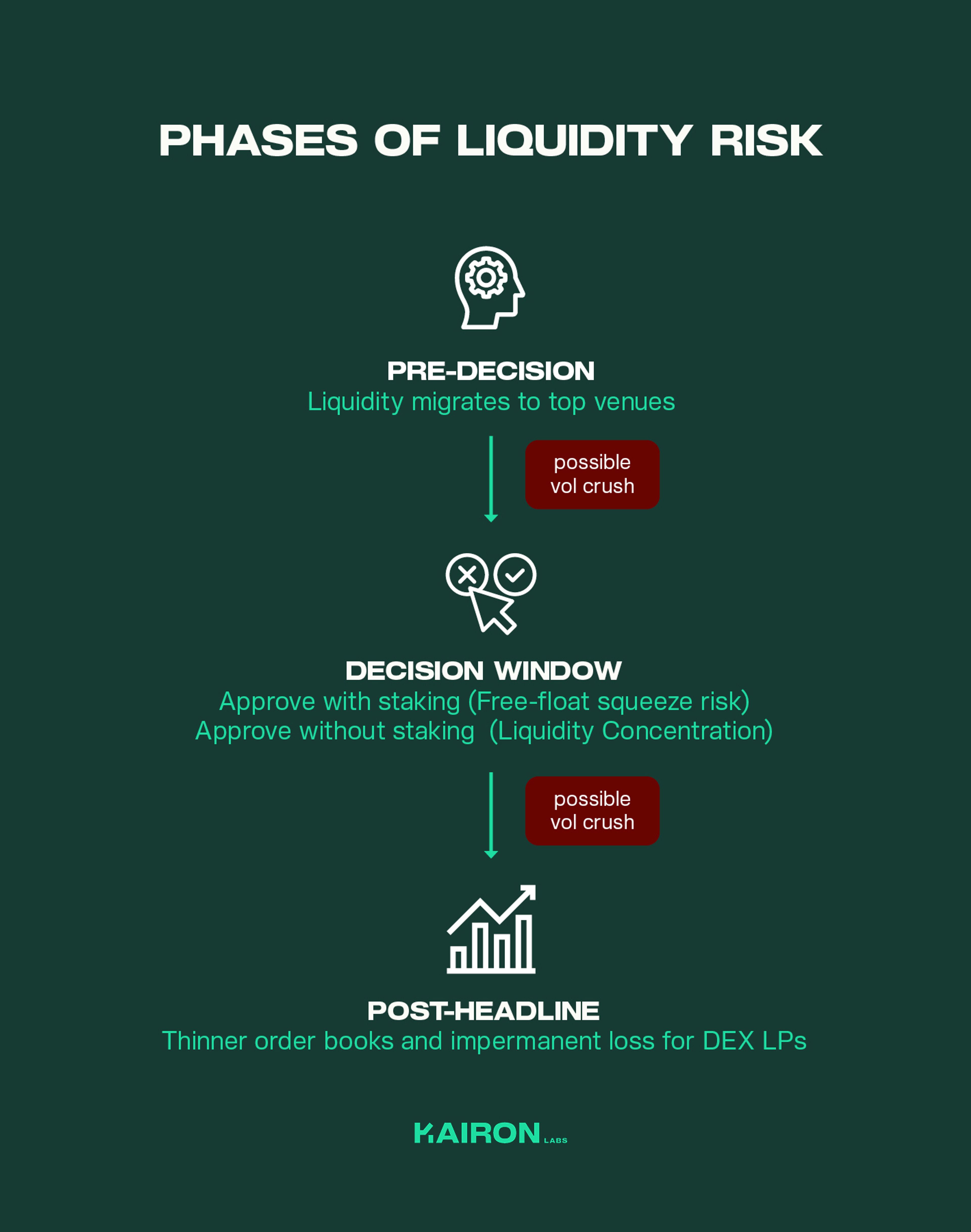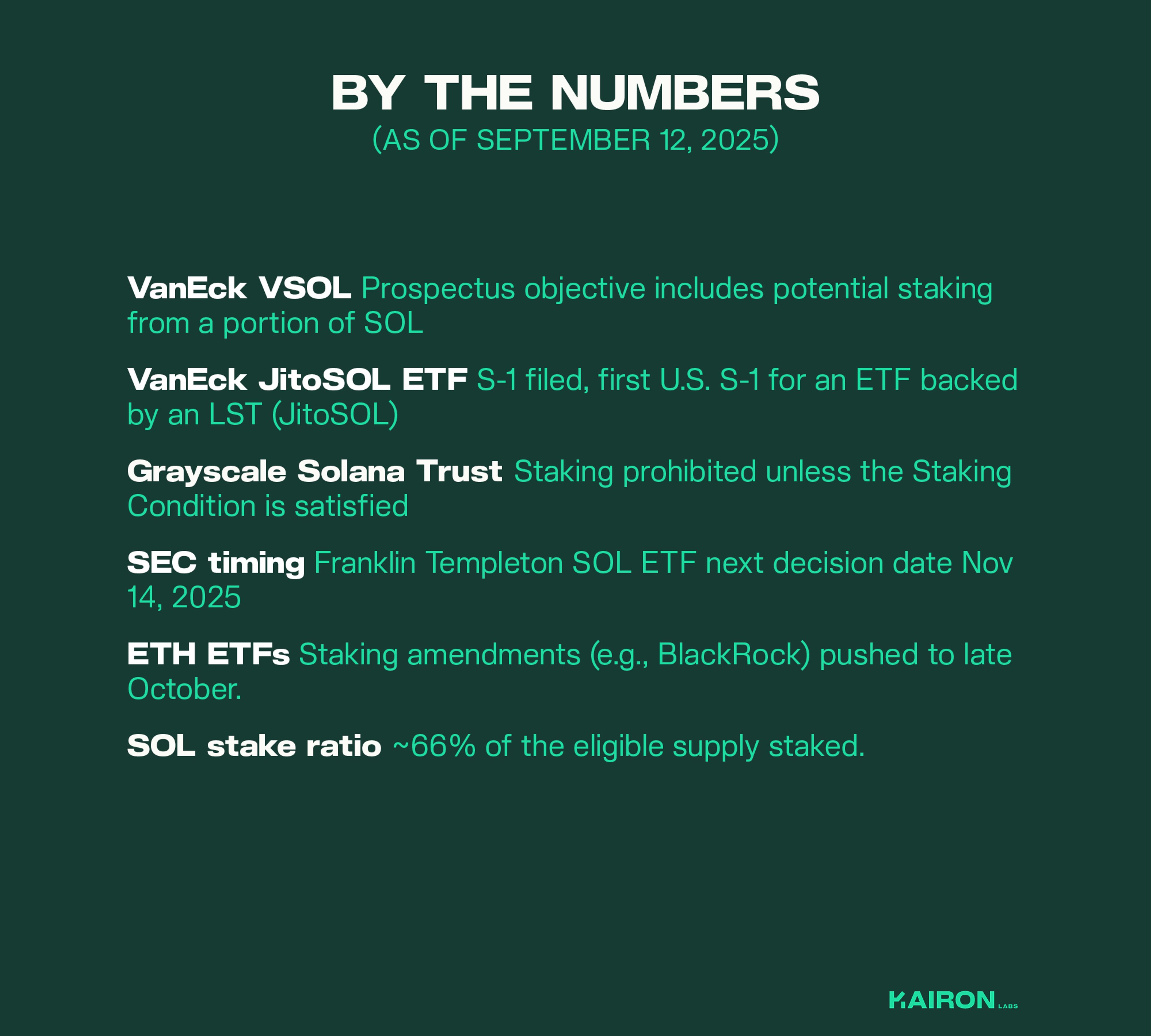
Solana Staking ETFs: A Live Liquidity Stress Test for Every Founder

The crypto world is buzzing again, but this time, the narrative around Solana (SOL) ETFs carries a distinct and crucial differentiator: staking. Recent filings from financial giants like VanEck and Grayscale aren't just proposing another spot ETF; they're breaking new ground by including staking provisions. This isn't just a bullish signal for SOL. It’s a profound evolution in how traditional finance views and interacts with proof-of-stake assets, and a live stress test for token liquidity.
With the next SEC decision dates for key filings clustering in October and November, market anticipation is intensifying. For token teams and market makers in the Solana ecosystem, these developments aren't merely headlines—they're a critical examination of volatility, spreads, and the very resilience of their token markets.
Note: We don’t manage ETFs or trade securities. We specialize in crypto liquidity strategies—ensuring that when narratives spark sudden inflows, your token’s market is ready to handle them.
Why This Cycle Is Different
A single news story can trigger explosive and usually unpredictable market movements in crypto. The Solana ETF filings with staking provisions are a perfect example. They captured attention and sent capital flowing. This is why this cycle is so different from what we've seen before:
- Staking in scope. VanEck’s Solana ETF (VSOL) prospectus states its objective includes staking a portion of the Trust’s SOL, subject to legal/regulatory constraints.
- Grayscale’s stance. Grayscale’s Solana Trust does not stake today and says staking would require satisfaction of a Staking Condition tied to grantor-trust tax treatment.
- Liquid staking on the table. VanEck also filed a separate JitoSOL ETF (holds LST JitoSOL), underscoring that U.S. vehicles may pursue staking economics one way or another.
- Regulatory timing. Decision windows cluster in October with additional dates now set in November (e.g., Franklin Templeton’s SOL ETF next decision date Nov 14, 2025).
- ETH contrast. U.S. spot ETH ETFs currently do not stake; the SEC just pushed back decisions on staking amendments (e.g., BlackRock) to late October.
So what? If U.S. products can stake, some SOL will migrate to validators, reducing the immediately tradable supply. With ~66% of eligible SOL already staked, any incremental lock-ups from institutional capital matter.
The Liquidity Mechanics: A Founder’s Playbook
Liquidity shocks occur when trading activity exceeds the available depth in an order book, resulting in wider spreads and increased slippage. While often triggered by narrative hype, the staking component amplifies this effect. The journey from ETF filing to a potential decision creates distinct phases of risk.
A simple map of risk, phase by phase:

- Pre-Window (Now → Decision): Speculators pile in; liquidity migrates to top venues; smaller books hollow out. Expect wider price swings and more slippage in long-tail pairs as order books get thinner.
- Decision Window (Approve/Deny/Delay): This is the most critical period.
- Approve with Staking: This poses a free-float squeeze risk. The market’s depth must scale incredibly fast, or spreads will gap, and trading will become inefficient.
- Approve without Staking: A relief rally is possible, but liquidity will remain highly concentrated, leaving smaller projects vulnerable.
- Delay: A "vol crush" can occur, followed by choppy trading. Spreads normalize unevenly, and stranded inventory becomes a real risk for market makers.
- Post-Headline Rebalancing: If a product stakes, the available liquid SOL for active trading declines. Order books get thinner, and smaller trades move the price more. DEX LPs take higher impermanent loss during swings, underscoring the need for advanced pool management.
What to Do Now: Actionable Steps
For token projects in the Solana ecosystem, this is a live fire drill. Your market’s resilience will be put to the test. Here are a few actionable steps you can take today:
1. Harden Depth Where Flow Concentrates.
Pre-seed depth on the top 3–5 venues and pairs your holders actually use. Keep your long-tail venues alive to avoid "orphan prints" (isolated trades with no surrounding liquidity).
2. Run Event-Mode Spread Bands.
Define specific spread ceilings for calm, volatile, and event-driven regimes. Enforce them with automated kill-switches to prevent orders from filling at wildly unfavorable prices during a liquidity shock.
3. Set DEX IL Guards.
Utilize asymmetric ranges, dynamic fees, and inventory caps to safeguard your liquidity against impermanent loss. Be prepared to top up pools when utilization exceeds a predefined threshold.
4. Instrument the Float.
Track staked vs. liquid SOL and LST share. Treat the “free float” as a live input to your order book depth targets. This allows you to proactively adjust your liquidity strategy as the available supply shifts.
5. Pre-approve Inventory Routes.
Know exactly how you will move inventory across venues in 5–15 minute loops when spreads widen. This speed is crucial for maintaining a healthy market.
By the Numbers

- VanEck VSOL: Prospectus objective includes potential staking from a portion of SOL.
- VanEck JitoSOL ETF: S-1 filed, first U.S. S-1 for an ETF backed by an LST (JitoSOL).
- Grayscale Solana Trust: Staking prohibited unless the Staking Condition is satisfied.
- SEC timing: Franklin Templeton SOL ETF next decision date Nov 14, 2025.
- ETH ETFs: Staking amendments (e.g., BlackRock) pushed to late October.
- SOL stake ratio: ~66% of the eligible supply staked.
Bottom Line: Control the Liquidity, Navigate the Narrative, Master the Staking Impact
The Solana ETF filings, with their groundbreaking inclusion of staking, aren't just reshaping how token liquidity behaves under pressure; they're redefining it. These proposals represent a significant maturation of the crypto market, but they also introduce new variables into the liquidity equation.
You can’t control headlines or the SEC’s timeline—and you certainly can't control whether institutional capital decides to stake—but you can control how your market handles these powerful forces. Ensure your token's market is ready to thrive, not just survive, in this new, staking-infused ETF era.
Staking ETFs are changing market dynamics. Explore how a robust liquidity framework can help your token thrive.
Related Blogs:
Kairon Labs provides upscale market-making services for digital asset issuers and token projects, leveraging cutting-edge algorithmic trading software that is integrated into over 100+ exchanges with 24/7 global market coverage. Get a free first consult with us now at kaironlabs.com/contact
Featured Articles


Understanding Market-Making Models in Crypto

Solana Staking ETFs: A Live Liquidity Stress Test for Every Founder

Launching a Token 101: Why is Liquidity Important?

Airdrops and Retrodrops Decoded: A Comprehensive Guide
